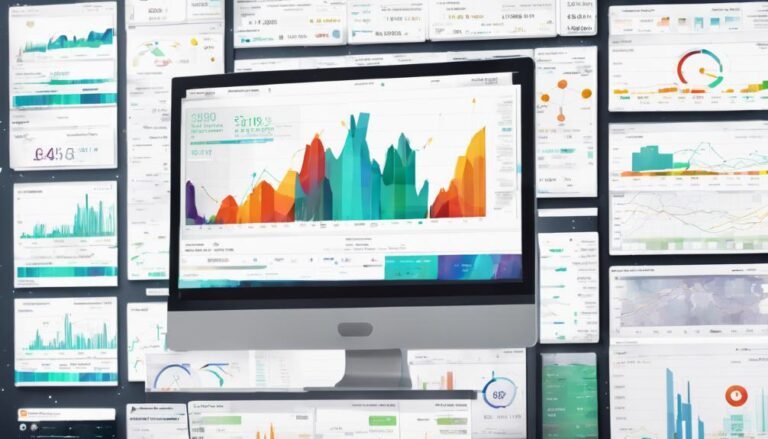AI in Market Risk Management
In the ever-evolving landscape of market risk management, AI has become the cornerstone of innovation and efficiency. With its ability to analyze vast amounts of data and identify patterns that may elude human observation, AI has transformed risk assessment in unprecedented ways. But how exactly does AI navigate the intricate web of market uncertainties and offer a glimpse into the future of risk management practices? Let's explore the intricate role AI plays in revolutionizing market risk management and the implications it holds for financial institutions seeking to navigate turbulent markets with confidence.
Key Takeaways
- Implement AI for accurate risk assessment.
- Utilize machine learning for predictive analytics.
- Enhance risk modeling with AI algorithms.
- Incorporate volatility forecasting techniques.
- Improve decision-making with real-time risk monitoring.
Advanced Risk Modeling Techniques
When implementing AI in market risk management, utilizing advanced risk modeling techniques can enhance predictive accuracy and decision-making processes. Risk mitigation strategies are essential in maneuvering through the complexities of financial markets.
By incorporating scenario analysis into risk models, you can evaluate potential outcomes under different circumstances, enabling proactive risk management.
Volatility forecasting is a vital aspect of market risk management. Advanced AI algorithms can analyze historical data and market trends to predict future volatility levels accurately. This information is invaluable for making informed investment decisions and implementing effective risk mitigation strategies.
Stress testing techniques play an important role in evaluating the resilience of your portfolio under adverse market conditions. AI-powered risk models can simulate various stress scenarios, helping you identify vulnerabilities and adjust your risk management strategies accordingly.
Automated Compliance Solutions
Implementing automated compliance solutions streamlines regulatory processes and enhances operational efficiency in market risk management. These solutions utilize AI algorithms to guarantee compliance with changing regulations, reducing the risk of potential penalties due to non-compliance. Automated compliance solutions help in monitoring activities such as algorithmic trading to make sure they adhere to regulatory standards.
By automating compliance checks, organizations can greatly reduce the time and resources required for manual monitoring, allowing for a more efficient allocation of resources towards other critical areas of risk management. Additionally, these solutions provide real-time insights into regulatory oversight, enabling proactive risk mitigation strategies.
Through the integration of automated compliance solutions, market participants can enhance their risk management frameworks, improving overall compliance posture while staying abreast of regulatory changes in the dynamic landscape of market risk management.
Real-time Risk Monitoring
How can real-time risk monitoring systems revolutionize market risk management practices in today's fast-paced financial landscape?
Real-time risk monitoring offers an immediate and dynamic approach to identifying, evaluating, and mitigating risks as they occur. By utilizing advanced algorithms and machine learning, these systems can process vast amounts of data in real-time, providing up-to-the-minute insights into market conditions and potential risks.
One key advantage of real-time risk monitoring is its ability to enhance risk mitigation strategies. By continuously analyzing market data and identifying outliers or anomalies, these systems enable proactive risk management actions to be taken swiftly, minimizing potential losses and maximizing opportunities.
Furthermore, data visualization plays an essential role in real-time risk monitoring. Through intuitive graphs, charts, and dashboards, complex data sets are transformed into visual representations that aid in quick decision-making. These visualizations allow market risk managers to grasp information rapidly and respond promptly to changing market conditions, ultimately improving overall risk management effectiveness.
Predictive Analytics Applications
What role do predictive analytics applications play in enhancing market risk management strategies in today's financial industry?
Predictive analytics applications are essential for interpreting vast amounts of data to forecast potential risks accurately. By utilizing advanced algorithms and statistical models, these applications can analyze historical data, market trends, and other relevant information to identify patterns and predict future market movements.
Data interpretation is a key aspect of predictive analytics, allowing financial institutions to make informed decisions based on historical data analysis and real-time market information. This helps in understanding potential risks and opportunities, enabling proactive risk management strategies.
Furthermore, predictive analytics applications aid in risk forecasting by providing insights into potential market fluctuations and identifying potential areas of concern. By leveraging predictive analytics, financial firms can anticipate market changes and adjust their risk management strategies accordingly, reducing exposure to unforeseen risks.
Machine Learning for Risk Assessment
Machine learning algorithms enhance risk assessment capabilities by analyzing vast datasets to identify patterns and predict potential market risks in the financial industry. By leveraging advanced algorithms, machine learning facilitates accurate risk prediction by examining historical data and real-time market information. These models can assess a wide range of risk factors simultaneously, providing a detailed view of potential threats to financial stability.
Data analysis plays an essential role in refining risk assessment models, enabling organizations to extract valuable insights from complex datasets and improve decision-making processes. Machine learning algorithms can swiftly process large volumes of data, detecting correlations and anomalies that might go unnoticed through traditional methods. This analytical approach enhances the accuracy of risk predictions and helps financial institutions stay ahead of potential market fluctuations.
Conclusion
To sum up, AI in market risk management is a game-changer, revolutionizing the way financial institutions predict and mitigate risks. By leveraging advanced algorithms and machine learning techniques, AI enables real-time risk monitoring, scenario analysis, and predictive analytics.
This technology empowers decision-makers to make informed choices and navigate volatile markets effectively. With AI at their disposal, financial institutions can stay ahead of the curve and protect their investments with precision and confidence.







